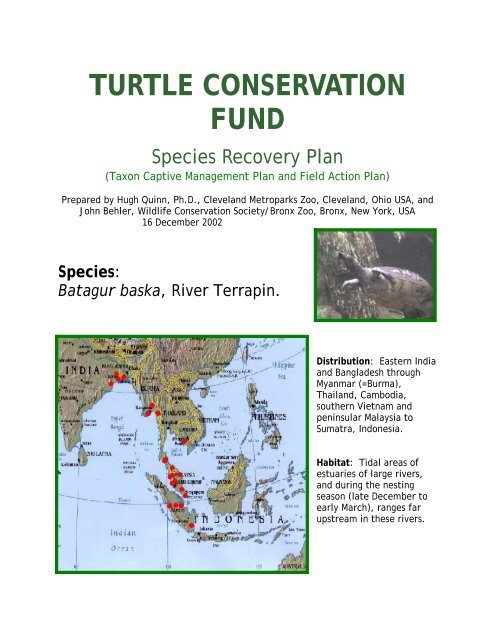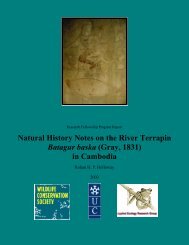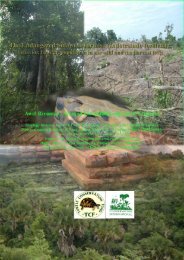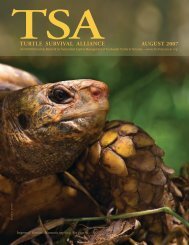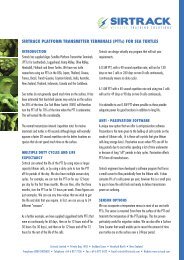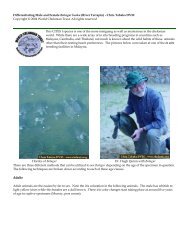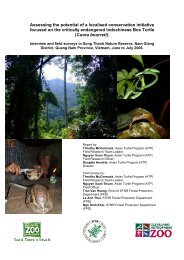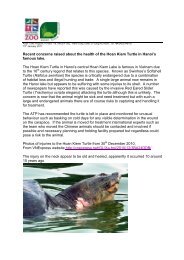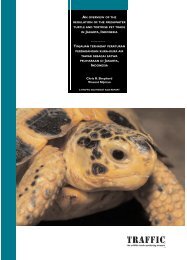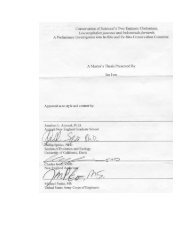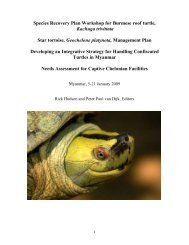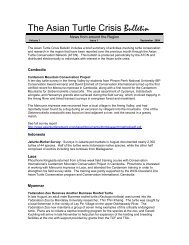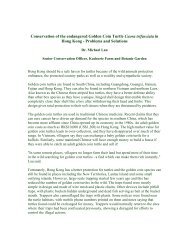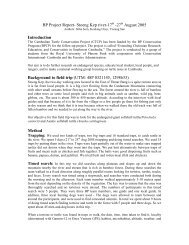Turtle Conservation Fund - Species Recovery Plan for Batagur baska
Turtle Conservation Fund - Species Recovery Plan for Batagur baska
Turtle Conservation Fund - Species Recovery Plan for Batagur baska
Create successful ePaper yourself
Turn your PDF publications into a flip-book with our unique Google optimized e-Paper software.
TURTLE CONSERVATION<br />
FUND<br />
<strong>Species</strong> <strong>Recovery</strong> <strong>Plan</strong><br />
(Taxon Captive Management <strong>Plan</strong> and Field Action <strong>Plan</strong>)<br />
Prepared by Hugh Quinn, Ph.D., Cleveland Metroparks Zoo, Cleveland, Ohio USA, and<br />
John Behler, Wildlife <strong>Conservation</strong> Society/Bronx Zoo, Bronx, New York, USA<br />
16 December 2002<br />
<strong>Species</strong>:<br />
<strong>Batagur</strong> <strong>baska</strong>, River Terrapin.<br />
Distribution: Eastern India<br />
and Bangladesh through<br />
Myanmar (=Burma),<br />
Thailand, Cambodia,<br />
southern Vietnam and<br />
peninsular Malaysia to<br />
Sumatra, Indonesia.<br />
Habitat: Tidal areas of<br />
estuaries of large rivers,<br />
and during the nesting<br />
season (late December to<br />
early March), ranges far<br />
upstream in these rivers.
Protected Status:<br />
CITES I<br />
Quotas: (unknown)<br />
The species is fully protected from all <strong>for</strong>ms of exploitation under domestic<br />
legislation in India, Indonesia, Myanmar and Thailand. It is scheduled <strong>for</strong> inclusion<br />
in as-yet unapproved legislation in Cambodia, and is not legally protected in<br />
Bangladesh and Vietnam (though export would be prohibited under their CITES<br />
obligations) (P.P. van Dijk, personal Communication).<br />
<strong>Conservation</strong> Status:<br />
IUCN Red List –Critically Endangered<br />
Summary of trade and threats: Presumed extinct in Myanmar, Vietnam, and<br />
Singapore. Eggs and adults are over exploited <strong>for</strong> food. Populations<br />
are also declining due to destruction of mangrove <strong>for</strong>ests, sand<br />
mining, damming of rivers (Moll, 1990; Moll and Moll, 2000), and<br />
probably pollution (P.P. van Dijk, personal communication) (see<br />
conservation and research needs section below <strong>for</strong> more details).<br />
Status In Captivity:<br />
20.35.50 (105) from 13 institutions listed worldwide in ISIS and in<br />
the international studbook currently under preparation at Cleveland Metroparks<br />
Zoo (Table 1).<br />
<strong>Batagur</strong> has successfully reproduced outside Asia only at the Bronx Zoo. One<br />
female there produced four clutches over eleven years (1990, 1995, 1999, 2001).<br />
Reproductive success in Asian collections is not fully known at this time;<br />
however, head starting, captive propagation and/or hatchery programs exist in<br />
the following countries:<br />
1. Malaysia: This program is administered by the Department of Wildlife and<br />
National Parks – PERHILITAN, in conjunction with District Offices. Captive<br />
breeding facilities <strong>for</strong> <strong>Batagur</strong> are located at a) Bota Kanan in Perak<br />
(established in 1968), b) Bukit Paloh in Terengganu (established in 1976),<br />
and c) Bukit Pinang in Kedah (established in 1978) (bin Abdul, 1998).<br />
2. Thailand: A <strong>Batagur</strong> breeding facility is located at the Thai Fisheries<br />
Department’s Satun Freshwater Fisheries Development Station at La-nguin<br />
in Satun Province.<br />
3. India: Eggs are removed from West Bengal Forest Department Project Tiger<br />
Sanctuary at Bagmara to a hatchery at Pakhiralaya.<br />
Reproduction is fairly widespread in these facilities, but training is needed in<br />
husbandry, veterinary care and egg incubation techniques (Moll and Moll, 2000;<br />
P.P. van Dijk, personal communication).
TMG Point Person(s): Hugh Quinn, Ph.D. (General Curator, Cleveland Metroparks<br />
Zoo, Cleveland, Ohio USA), and John Behler (Curator, Department of Herpetology,<br />
Wildlife <strong>Conservation</strong> Society – Bronx Zoo, Bronx, New York USA).<br />
Identify the TSA partners in this TMG and Describe their expertise and abilities<br />
(Note: additional partners will be solicited as the program develops) (numbers in<br />
parentheses indicate number of <strong>Batagur</strong> male, female and unknown sex, respectively<br />
at the facilities indicated):<br />
John Behler, Wildlife <strong>Conservation</strong> Society –Bronx Zoo: large heated indoor pool;<br />
four successful breedings. (5.6.1)<br />
Hugh Quinn, Cleveland Metroparks Zoo: two large heated indoor pools; interested<br />
in importing founder stock from Asian collections to North American collections.<br />
(2.3.0)<br />
Dan Badgley, Columbus Zoo. (0.0.0)<br />
Francis Lim, Singapore Zoological Gardens: (8.12.0)<br />
Alan Kardon, San Antonio Zoo: Large outdoor enclosures with natural well water<br />
flowing through at a constant temperature year round. (1.3.0)<br />
Don Boyer, San Diego Zoo: Large, outdoor pool. (1.1.0)<br />
Lonnie McCaskill, Disney’s Animal Kingdom; interested in importing founder stock;<br />
will construct new, outdoor off-exhibit facilities. (0.0.0)<br />
Gerald Kuchling, Chelonia Enterprises. (0.0.0)<br />
Peter Paul van Dijk, IUCN/SSC Tortoise and Freshwater <strong>Turtle</strong> Specialist Group.<br />
(0.0.0)<br />
Scott Pfaff, Riverbanks Zoo; interested in exhibiting and reproducing, indoor<br />
facilities (0.0.0)<br />
John Brueggen, St. Augustine Alligator Farm; Outdoor facilities available. (0.0.0)<br />
Harald Artner, Chelonia 2002; indoor facilities. (0.0.0)<br />
David Martini (0.0.0)<br />
Bill Neisling (Florida); Outdoor Facility. (0.1.0)<br />
Provide signatures of all partners indicating that they agree to TSA Guidelines <strong>for</strong><br />
participation in the TMG, and that they will comply with the recommendations of<br />
that particular TMG
Describe suitability of facilities participating in this TMG:<br />
N orth America: The indoor facilities indicated above have large indoor pools (Cleveland<br />
Metroparks Zoo, Wildlife conservation Society – Bronx Zoo). Outdoor facilities that Disney’s<br />
Animal Kingdom may construct are large pools. The San Antonio Zoo has large outdoor<br />
enclosures with natural well water flowing through at a constant temperature year round.<br />
Bill Neisling (Florida) has a large outdoor pool.<br />
Malaysia: Jasmi bin Abdul (1998) reports that in Malaysia the breeding complex at Bota<br />
Kanan, Perak consists of breeding ponds and an artificial sandbar <strong>for</strong> nesting, as well as<br />
amenities <strong>for</strong> rangers and visitors. The hatchery has been designated a tourist site, and<br />
attracts many visitors. There are also three large culture ponds. The main pond is divided<br />
into four compartments to raise hatchlings to four-years of age (which are then released).<br />
The other two ponds are <strong>for</strong> breeding adults. The program began in 1968 with an initial stock<br />
of 68 <strong>Batagur</strong>. More adults were introduced in subsequent years. The total <strong>Batagur</strong><br />
population at Bota Kanan in 1998 was 4,914.<br />
Breeding of the terrapin at Bukit Pinang, Kedah began in 1978. The ponds here are slightly<br />
smaller than those at Bota Kanan, Perak, and about 1,800 animals reside at this facility.<br />
Breeding at Bukit Paloh, Ulu Terengganu began in 1976. The ponds here are also slightly<br />
smaller than those at Perak, and about 1,040 animals reside here.<br />
In Malaysia, eggs are collected in the wild by licensed collectors near the above facilities each<br />
year. About 5,000 eggs are collected annually in Terengganu and Kedah, but about 24,000<br />
are harvested in Perak (bin Abdul, 1998). The Department of Wildlife and National Parks<br />
(PERHILITAN) buy 20% of the eggs collected by the villagers <strong>for</strong> its breeding programs in the<br />
above three facilities. PERHILITAN rangers go to the nesting beaches to buy the eggs be<strong>for</strong>e<br />
they are sold to the public. Eggs are then incubated in artificial nests, about 60 cm deep,<br />
accommodating 20 – 30 eggs each. The openings to the nests are fenced with wire mesh to<br />
protect them from predators, and to prevent hatchlings from escaping. Hatching success is<br />
40% - 85%. Styrofoam boxes filled with sand are also used to incubate some eggs. Hatching<br />
success is higher with this method. Young are fed kangkong (Ipomea sp.), ripe banana and<br />
fish meal. They are released in their respective river systems at an age of about four years.<br />
Since 1968, over 30,000 young <strong>Batagur</strong> have been released into the Perak River.
Thailand: van Dijk (1999) reports that the only population remaining in Thailand exists in<br />
captivity at the Satun Freshwater Fisheries Development Station at La-ngu in Satun Province.<br />
This station was established in the early 1980s <strong>for</strong> breeding <strong>Batagur</strong> <strong>baska</strong> as well as Callagur<br />
borneoensis. It is located in a bend of the Klong La-ngu River and includes a sandy river<br />
beach on its grounds that was a natural breeding site until recently. For protection and<br />
control of the animals, a small section of the river and this nesting beach were fenced. Adult<br />
animals were caught whenever possible, and placed in this enclosure.<br />
The <strong>Batagur</strong> here originated not only from Klong La-ngu itself, but also from other provinces,<br />
from both the Andaman Sea and the Gulf of Thailand coasts. The total population is less than<br />
100 mature, wild-caught individuals, plus an unknown number (probably in the low 100s) of<br />
captive born offspring of different ages. Reproductive success is low compared to the number<br />
of mature females held at the station. The conditions under which these animals are<br />
maintained need to be improved significantly. This, in turn, should lead to improvements in<br />
the numbers of eggs and hatchlings produced. Many captive-born <strong>Batagur</strong> from this station<br />
have been released at a number of sites in Thailand, including Sirnagarind, Tha Thung Na, and<br />
Sirikit reservoirs; Thale Noi wetland and Klong La-ngu. Most of these sites are not conducive<br />
to <strong>Batagur</strong> survival, and there has been no reported sightings at any of the above locations<br />
since release.<br />
A concern is that all <strong>Batagur</strong> are kept at one site. The consequences of an infectious disease<br />
or other calamity striking this single site would be horrendous. It would be desirable to<br />
establish a second site and move about half the animals there. Suitable release sites <strong>for</strong><br />
animals produced at the station need to be identified. Such potential sites include the Klong<br />
La-ngu area itself, the mangroves of Laem Son National Park, and perhaps Khao Sam Roi Yot<br />
National Park (van Dijk, 1999).<br />
Descriptions of other Asian and Indian facilities are not yet available.<br />
Describe the ultimate goal of your captive population:<br />
Reintroduction through maintaining a viable captive population (assurance<br />
colony) over time. The goal is to maintain a large (300 specimens) captive<br />
population as an assurance colony (exclusive of the above mentioned facilities in<br />
Malaysia and Thailand) that is capable of producing large numbers of offspring <strong>for</strong><br />
reintroduction should this become necessary. This figure (300) is a liberal<br />
estimate, and may actually be lowered once appropriate analyses are conducted<br />
to estimate population size needed to meet the genetic goal stated below. Note:<br />
The goal of the Asian hatcheries described in the above section is to release<br />
hatchling and head-start turtles (see the conservation and research needs section<br />
below <strong>for</strong> more details).<br />
Genetic goal: The population will be managed to retain 90% gene diversity over<br />
100 years.
Number of founders (those wild-caught animals that have successfully<br />
reproduced in captivity) and potential founders (those wild-caught animals that<br />
have not yet reproduced in captivity) existing and number needed: Fifteen<br />
potential and at least two founders exist in North American collections. It is<br />
unknown if there is more than one founder male, as the founder female at the<br />
Bronx Zoo was housed with several males at the times of her reproductive events.<br />
Although the International <strong>Species</strong> Inventory System (ISIS) shows 79 specimens<br />
exist in Asian collections (Table 1), the number of founders and potential founders<br />
is not yet known. However, there are about 50 – 100 mature, wild collected<br />
animals plus hundreds of captive-hatched offspring, some approaching maturity, in<br />
Thailand, with larger numbers in Malaysia (see above descriptions of Asian<br />
facilities) (P.P. van Dijk, personal communication). There<strong>for</strong>e, if large holdings of<br />
founders and potential founders exist in these collections, there may already be<br />
enough animals in captivity to meet the genetic goal of this program. Problem:<br />
Populations from the Andaman Sea – Straits of Malacca may be genetically<br />
different from South China Sea populations, and animals from different coasts<br />
have certainly been brought together in the Satun Breeding Centre in Thailand and<br />
possibly stock or hatchlings have been moved between river basins within<br />
Peninsular Malaysia. Meanwhile, these Thai-Malay animals are definitely<br />
recognizably different from India-Bangladeshi animals (which almost certainly are<br />
not in western collections) (P.P. van Dijk, personal communication).<br />
Origin and location of founders and potential founder specimens: There are<br />
minimally two founders in North American collections, and these are both held at<br />
the Wildlife <strong>Conservation</strong> Society – Bronx Zoo. The number of founders and<br />
potential founders in Asian institutions is unknown at this time (Table 1).<br />
Target Population Size, i.e., the number of specimens required to maintain a<br />
genetically viable and demographically stable captive population. This number<br />
will be based on the reproductive and life history characteristics of the<br />
particular species, and may require the input of a biologist with small<br />
population management experience. A population analysis has not yet been<br />
conducted <strong>for</strong> this species. Few data <strong>for</strong> such an analysis are available, making<br />
the results speculative at best. Based on the longevity and fecundity of this<br />
species, a target population size of 100 is probably sufficient to meet our genetic<br />
goal. There<strong>for</strong>e, our arbitrary population size of 300 should be more than<br />
adequate to sustain this species. As further population data are available on<br />
<strong>Batagur</strong>, analyses will be conducted to further refine the target population size.<br />
Caution must be taken to not allow this species to needlessly consume limited<br />
space available <strong>for</strong> other large riverine <strong>for</strong>ms (i.e., Callagur, Orlitia). Attaining<br />
our goal of maintaining 300 turtles will require recruiting partners with additional<br />
indoor or year round outdoor facilities with adequate space, and in <strong>for</strong>ming<br />
partnerships with Asian institutions such as Singapore Zoological Gardens, Khao
Kheow Open Zoo (Thailand), Taiping Zoo (Malaysia), Zoo Negara (Malaysia), and<br />
Malacca Zoo.<br />
Define length of program: Long-term management (100 years) vs. short-term<br />
(emergency rescue/holding): This is a long-term program with a 100 year goal.<br />
Identify the sources <strong>for</strong> specimens included in this Management <strong>Plan</strong>: Sufficient<br />
captive specimens probably already exist to manage a healthy population, hence most<br />
likely no additional specimens from the wild will be needed. Confiscated turtles,<br />
however, should be integrated into the captive gene pool.<br />
Are husbandry techniques known<br />
If unknown, describe your techniques <strong>for</strong> husbandry and reproduction:<br />
Husbandry techniques are generally known, but breeding in North America has<br />
been known to occur at only one institution (Wildlife <strong>Conservation</strong> Society – Bronx<br />
Zoo) from only one female. Techniques need to be developed so this species can<br />
be consistently reproduced at multiple facilities. Multiple males may be an<br />
important factor in successful breeding, as may be seasonal changes in<br />
temperature, water level, water chemistry and food intake (P.P. van Dijk,<br />
personal communication).<br />
Has the species reproduced in captivity: Yes, multiple times, but in North<br />
America from only one female at only one institution. Reproduction in Asian<br />
institutions is relatively widespread, but training in husbandy, veterinary care and<br />
incubation techniques would be beneficial (P.P. van Dijk, personal<br />
communication).<br />
Does the species have a good or poor history in captivity Relatively good.<br />
Survives and grows well, but consistent reproductive success is problematic.<br />
Are there genetic issues that need to be resolved with this species<br />
Is this a wide-ranging species with many sub-populations where cryptic taxa<br />
may exist Wirot (1979) described <strong>Batagur</strong> <strong>baska</strong> ranongensis from Thailand as<br />
differing by its flat, round carapace, as opposed to the elongated, narrower<br />
carapace of normal adult B. <strong>baska</strong>. However, this probably just represents an<br />
abnormal growth pattern, as all juvenile B. <strong>baska</strong> are rounded, but become more<br />
elongated with age. Moll has told us that B. <strong>baska</strong> from the east coast of Malaysia<br />
differ in coloration from those of the west coast. Male animals of the Indian-<br />
Bangladeshi population develop red courtship coloration at the base of the neck<br />
and <strong>for</strong>elimbs, with the head and most of the neck deep black (Das, 1991; E.O.<br />
Moll, personal communication). This is unlike other populations, which have only<br />
the black coloration of the head, neck and <strong>for</strong>elimbs, with no red pigment. E. O.<br />
Moll has also noted a skeletal difference in the few<br />
skeletons that are available. In the shell of the<br />
Malaysian <strong>Batagur</strong> there is a fusion of two pleurals<br />
leaving a gap between posterior neurals. The two<br />
skeletons examined by him from the south Asia<br />
population (India/Bangladesh) do not show the<br />
pleural fusion. If this holds-up in examination of<br />
other specimens, the populations could potentially be<br />
considered separate species.
Do insular sup-populations exist that may differ genetically from mainland<br />
populations No differences noted to date, and most likely identical to the<br />
western peninsular Malaysian population (P.P. van Dijk, personal communication).<br />
Describe your TMG’s plan <strong>for</strong> managing this species:<br />
Managed as large groups or as pairs: <strong>Batagur</strong> is probably best managed in groups<br />
with multiple males and perhaps also multiple females.<br />
Describe how surplus will be managed once target population size is reached:<br />
We anticipate managing a captive population of approximately 300 specimens (or<br />
perhaps less) while striving to equalize representation from as many of the wildcaught<br />
specimens as possible. As unrepresented specimens contribute to the<br />
population, some turtles from over-represented founder lines may need to be<br />
surplused to create space. Space will be the primary limiting factor in designating<br />
surplus specimens.<br />
Describe plan <strong>for</strong> dispersal of offspring: If surplus stock cannot be placed with<br />
other TSA partners, then other non-participating private parties, institutions or<br />
organizations will be utilized.<br />
Describe the methods you will use to individually identify the turtles in this<br />
captive population: All specimens should be PIT tagged when appropriate size is<br />
attained <strong>for</strong> permanent identification. Hatchlings should be uniquely identified<br />
utilizing other means until they can be PIT tagged.<br />
Have Range Country Partners been identified<br />
Have linkages with NGOs and range country programs been investigated <strong>for</strong><br />
collaborative and eventual repatriation/relocation ef<strong>for</strong>ts Zoos in Asia,<br />
especially those with current holdings of this species, will be encouraged to<br />
collaborate with this program. It may also be important to work with the<br />
Department of Wildlife and National Parks in Malaysia and with the Satun Fisheries<br />
Station in Satun Province, Thailand. These two organizations have captive<br />
populations of adult <strong>Batagur</strong> and are breeding them in captivity. A population
eing raised in West Bengal, India may be the only one from the northern<br />
population (India/Bangladesh). However, it may have been derived from<br />
individuals of a single clutch (E.O. Moll, personal communication).<br />
Describe conservation and research needs <strong>for</strong> this species: This section is divided<br />
into ex-situ (in captivity) and in-situ (in nature) conservation needs. Key conservation<br />
issu es are first defined within each of these two divisions, then specific projects that<br />
may help rectify these issues are presented.<br />
Ex-situ <strong>Conservation</strong> Needs<br />
K ey <strong>Conservation</strong> Issues: Challenges involve developing appropriate husbandry and veterinary care<br />
programs <strong>for</strong> <strong>Batagur</strong> at certain facilities, especially in Asia. Improving turtle enclosures and<br />
supportive structures and equipment plus training <strong>for</strong> better animal care and incubation practices<br />
should accompany these programs. While the basic husbandry and veterinary care needs of <strong>Batagur</strong><br />
are fairly well known, this in<strong>for</strong>mation has not reached all facilities that may be important to the long-<br />
term management of this species in captivity. Other ex-situ challenges involve appropriate genetic<br />
and demographic management <strong>for</strong> long-term maintenance of captive populations. Another basic exsitu<br />
need is to develop procedures <strong>for</strong> consistent, successful reproduction, as this species does not<br />
regularly reproduce in captivity.<br />
Specific Projects:<br />
1. Husbandry and Population Management Training: Training of a) North American Taxon<br />
Management Group (TMG) leaders in studbook keeping and population management,<br />
and b) Asian turtle caretakers in husbandry and veterinary care (particularly personnel<br />
from the Malay and Thai head-start facilities mentioned in the above Status in<br />
Captivity section) is a project proposed by Cleveland Metroparks Zoo. This project<br />
additionally provides funding <strong>for</strong> Asian turtle facility enhancement, and the creation of<br />
an Asian Regional Coordinator (<strong>for</strong> Tortoise and Freshwater <strong>Turtle</strong> <strong>Conservation</strong>)<br />
position(s). This is a two year program, with a total budget $159,748. $60,000 has<br />
already been received from the G.G. Wade Foundation (Cleveland, Ohio) and<br />
Cleveland Zoological Society. A $75,000 grant proposal has been submitted to the<br />
Institute of Museum and Library Services (IMLS) by Cleveland Metroparks Zoo <strong>for</strong><br />
additional funding.<br />
2. Temperature Dependent Sex Determination (TDSD): Research is needed in this field,<br />
3.<br />
as many eggs are currently incubated in Malaysian, Thai and Indian hatcheries as<br />
components of release programs. TDSD will also be important in other captive<br />
breeding and long-term captive management programs <strong>for</strong> <strong>Batagur</strong>. The only<br />
significant funding needed <strong>for</strong> this project would be <strong>for</strong> analysis of hormone levels in<br />
hatchling blood samples. The problem here is that the analysis most likely would be<br />
done in the US from samples taken in Asia. In doing so, CITES I permits would be<br />
required. Alternatively, it may be possible to link with Thai and Malaysian universities<br />
if protocols are developed. Total budget unknown.<br />
Reproductive Biology of <strong>Batagur</strong>: Cleveland Metroparks Zoo is in the initial stages of<br />
developing a project to simultaneously trace 1) estrogen, progesterone and<br />
testosterone levels, and 2) ovarian and testicular development (through ultrasound<br />
imagery), while all the time looking at behavioral and environmental correlates with<br />
these factors. This research will help us better understand the reproductive cycles of<br />
<strong>Batagur</strong>, and provide insight into consistently reproducing this species in a captive<br />
environment. Total budget unknown.
In-Situ <strong>Conservation</strong> Needs<br />
Key <strong>Conservation</strong> Issues: Factors resulting in<br />
the decline of <strong>Batagur</strong> in the wild are summarized by Moll (1990) and Mo ll and Moll (2000), and include:<br />
1. Direct removal of animals and eggs from the wild <strong>for</strong> human food.<br />
2. Destruction of nesting beaches by sand mining.<br />
3. Creation of dams that:<br />
a. alter downstream water levels (flooding beaches when regular water releases are made<br />
during nesting season).<br />
b. destroy downstream nesting beaches (by: 1) washing<br />
them away during water releases,<br />
2) not allowing sand to wash downstream to re-<strong>for</strong>m or maintain them, and 3)<br />
depositing silt over the sand beaches making them inappropriate <strong>for</strong> nesting).<br />
c. block migration routes from estuaries to upstream nesting beaches.<br />
4. Destroy mangrove <strong>for</strong>ests that provide prime <strong>for</strong>aging habitat <strong>for</strong> this species.<br />
5. Pollution of rivers with domestic effluent and agro-industrial pollutants, particularly pesticides<br />
(P.P. van Dijk, personal communication).<br />
In situ conservation needs <strong>for</strong> <strong>Batagur</strong> should address these issues, and thus involve 1)<br />
en<strong>for</strong>cing of existing protective measures <strong>for</strong> the species, 2) establishing reserves that contain<br />
both <strong>for</strong>aging and nesting areas, including providing assistance in en<strong>for</strong>cing regulations <strong>for</strong><br />
protection in existing reserves (less of an issue than the fact that there are no adequate<br />
protected areas fully embracing an entire population’s feeding and nesting habitats) (P.P. van<br />
Dijk, personal communication), and 3) conducting public education programming in and<br />
around such reserves and in non-protected areas (where <strong>Batagur</strong> populations exist) (Moll,<br />
1990; Moll and Moll, 2000).<br />
Additionally, techniques need to be developed to successfully re-establish populations within<br />
the historic range (or bolster fragile extant populations) of this species from captive bred or<br />
head started turtles. Such techniques are not well established, and programs <strong>for</strong> other retiles<br />
employing them have received criticism as to their conservation effectiveness (Burke, 1991;<br />
Dodd and Seigel, 1991; Reinert, 1991; Seigel and Dodd, 2000). These programs must first 1)<br />
rectify the cause of decline suffered by the historic or fragile populations, and 2) employ<br />
structured, evaluative measures to access their usefulness and, if necessary, appropriately<br />
adjust their methodology. Only by utilizing sound, scientific principles in designing,<br />
implementing and evaluating release programs will we evaluate their usefulness as<br />
conservation tools.<br />
Specific Projects:<br />
1. Support of Existing Reserves:<br />
Malaysia: Peter Paul van Dijk tells us that there is a good <strong>Batagur</strong> population in the<br />
Setiu River of NE peninsular Malaysia that nests in a nominally protected area at the<br />
estuary. There’s Callagur there as well. Dino Sharma (WWF-MY) has worked on the<br />
Callagur <strong>for</strong> years and would be interested in expanding conservation and research<br />
work to <strong>Batagur</strong> if funding and dedicated staff to do the field management could be<br />
obtained. Qualifications needed are ability to speak Malay and having an<br />
understanding of turtle ecology and conservation biology. Total budget unknown.
E.O. Moll suggests (personal communication) that a good possibility <strong>for</strong> another<br />
reserve in Malaysia is at Bota Kanan, Perak. The West Malaysian Department of<br />
Wildlife and National Parks declared this nesting area (probably the best in Malaysia) a<br />
sanctuary. Un<strong>for</strong>tunately, it is largely a sanctuary in name only. While river terrapin<br />
adults are protected in the region, egg collecting is still permitted by obtaining a<br />
license. Sand mining is also allowed. If the Department of Wildlife could be talked<br />
into giving the eggs and animals protection and prohibiting sand mining, this would be<br />
a excellent nesting reserve. Ideally, another preserve would need to be established in<br />
the estuary of the river protecting the habitat, particularly the small tributaries,<br />
where the turtles feed at high tide. The area gazetted on the Dugun River (east coast)<br />
<strong>for</strong> egg collection would be another possibility. Total budget unknown.<br />
Sumatra: There may also exist good possibilities In Sumatra, but specific areas have<br />
yet to be identified.<br />
Thailand: There is also potential to implement<br />
protection of the Klong La-ngu (=La-ngu Creek) in<br />
Satun, Thailand, and restore the existing nesting<br />
beach to <strong>Batagur</strong>. The nesting beach is within the<br />
compound of the Satun fisheries station, but since all<br />
the <strong>Batagur</strong>s are penned-in, not much is happening<br />
at the moment. Lots of potential (P.P. van Dijk,<br />
personal communication). Total budget unknown.<br />
Cambodia: <strong>Batagur</strong> was re-discovered at Sre Ambel,<br />
Cambodia in January 2001 (along the Kaong River,<br />
Kompong Seila District, Koh Kong Province) by the<br />
Department of Fisheries and Wildlife <strong>Conservation</strong> Society. <strong>Conservation</strong> measures<br />
needed are to 1) safeguard nesting sites, 2) protect the non-breeding population, 3)<br />
raise awareness to people living near this population of the conservation importance<br />
of this species, and 4) monitor fishing activities and en<strong>for</strong>ce fisheries laws (Sovannara,<br />
2002). Specific recommended actions include: 1) conduct further surveys to locate<br />
additional nesting sites, 2) carry-out additional educational programming in villages<br />
and schools along the Kaong River, 3) monitor the <strong>Batagur</strong> population to detect trends,<br />
and 4) utilize telemetry to define use areas outside of the nesting season. Total<br />
budget unknown.<br />
2. Nesting Beach Restoration/Protection: Nesting beach restoration/protection should be<br />
an integral, emphasized part of protected areas (as outlined in #1 above).<br />
3. Survival of Head Started/Hatchery Released <strong>Batagur</strong>: All head started animals should<br />
minimally be marked (simply shell-notch each cohort). Raising a few of them <strong>for</strong> a<br />
year or so, and putting transmitters on them would help evaluate releases. If these<br />
releases are to continue, there needs to be an evaluation process set in place to see if<br />
the program is doing any good (or harm!). Perhaps some good ideas on this issue can<br />
be developed in a first year of interaction with Thai and Malaysian partners while<br />
implementing the husbandry and veterinary care courses. Total budget unknown.
4. Dams: Dams are also a problem with Chitra (P.P. van Dijk, personal communication).<br />
E.O. Moll (personal communication) suggests trying to get dam operators to not flood<br />
sand banks during the several months that the turtles are nesting and the eggs are<br />
developing.<br />
5. A stock-taking activity with on-the-ground inspection of Asian facilities and captive<br />
stocks as well as pulling together all available habitat and wild population status data,<br />
followed by a thorough discussion of management options, would be very desirable.<br />
There are a couple of independent populations established over the past decade or<br />
two with different management practices in place, and it would be good to evaluate<br />
what worked and why, and what did not work and why (P.P. van Dijk, personal<br />
communication). This activity could potentially be conducted by the Asian<br />
Coordinator(s) outlined in the above section on ex-situ specific projects. Total budget<br />
unknown.<br />
6. Systematics: As mentioned in the above section on genetic issues, there are<br />
systematic questions that need to be addressed. In particular, the northern<br />
populations (India and Bangladesh) may be highly distinctive from the others, and the<br />
eastern and western Malay populations may be, to a lesser degree, differentiated.<br />
Total budget unknown.<br />
Selected Literature: The following section lists a few papers, reports and books that<br />
contain in<strong>for</strong>mation about <strong>Batagur</strong> <strong>baska</strong> that may be of interest to those working<br />
with this species. Copies of some are available without charge <strong>for</strong>m Cleveland<br />
Metroparks Zoo (Hugh Quinn, hrq@clevelandmetroparks.com).<br />
Balasingham, E. and Mohamed Khan Bin Momin Khan. 1969. <strong>Conservation</strong> of the<br />
Perak River terrapins (<strong>Batagur</strong> <strong>baska</strong>). Malay. Nature J. 23:27 – 29.<br />
Bhaskar, S. 1990. Biology and conservation of <strong>Batagur</strong> <strong>baska</strong>. Report to World<br />
Wildlife <strong>Fund</strong>. 24 pp.<br />
Bhupathy, S., B. C. Choudhury, and E. O. Moll. 1992. <strong>Conservation</strong> and management of<br />
freshwater turtles and land tortoises of India. Technical report (May 1991 – July<br />
1992), Wildlife Institute of India, Dehra Dun. 22 pp.<br />
Blanco, S., Behler, J.L., and Kostel, F. 1991. Propagation of the <strong>Batagur</strong>ine turtles<br />
st<br />
<strong>Batagur</strong> <strong>baska</strong> and Callagur borneoensis at the Bronx Zoo. In: Proceedings 1<br />
International Symposiumon <strong>Turtle</strong>s and Tortoises: <strong>Conservation</strong> and Captive<br />
Husbandry. Pp. 63 – 65.<br />
Das, I. 1992. <strong>Turtle</strong> conservation programme at the Madras Crocodile Bank. Tigerpaper<br />
29(1):16 – 17.<br />
Davenport, J., T. M. Wong, and J. East. 1992. Feeding and digestion in the omnivorous<br />
estuarine turtle <strong>Batagur</strong> <strong>baska</strong> (Gray). Herpetological Journal 2(4):133 – 139.<br />
Ernst, C. H. and R. W. Barbour. 1989. <strong>Turtle</strong>s of the world. Smithsonian Institution<br />
Press. Washington, D. C. and London. 333 p.<br />
Gosh, A. and N. R. Mandal. 1990. Studies on nesting and artificial hatching of the<br />
endangered river terrapin, <strong>Batagur</strong> <strong>baska</strong> (Gray), in the Sundarbans Tiger<br />
Reserve, West Bengal. J. Bombay Nat. Hist. Soc. 87(1):50 – 52.<br />
Khan, M. K. M. 1964. A note on <strong>Batagur</strong> <strong>baska</strong> (the river terrapin or tuntong). Malay.<br />
Nat. J. 18:184 – 186.<br />
Khan, M. K. M. 1977. River terrapin. Nature Malaysiana 2(3):32 – 37.<br />
Loch, J. H. 1950. Notes on the<br />
Perak River turtle. Malay. Nat. J. 5:157 – 160.
Maxwell, F. D. 1911. Reports on the inland and sea fisheries in the Thongwa,<br />
Myaungmya, and Bassein Districts and turtle banks of the Irrawaddy Division,<br />
Rangoon.<br />
Moll, D. 1995. <strong>Conservation</strong> and management of river turtles: a review of methodology<br />
and techniques. In: SOPTOM (ed.) Proceedings, International Congress of<br />
Chelonian <strong>Conservation</strong>, 6 – 10 July 1995, Gonfaron. Editions SOPTOM,<br />
Gonfaron, pp. 290 –294.<br />
Moll, E. O. 1976. West Malaysian turtles: utilization and conservation. Herpetol. Rev.<br />
7:163 – 166.<br />
Moll, E. O. 1978. Drumming along the Perak. Natur. Hist. 87:36 – 43.<br />
Moll, E. O. 1980. Natural history of the river terrapin <strong>Batagur</strong> <strong>baska</strong> (Gray) in Malaysia<br />
(Testudines: Emydidae). Malaysian Journal of Science 6(A):23 – 62.<br />
Moll, E. O. 1984. Freshwater turtles of India: Their status, conservation and<br />
management. Hamadryad 9(3):9 – 17.<br />
Moll, E. O. 1984. River terrapin recovery plan <strong>for</strong> Malaysia. J. Wildlife and Parks 3:37<br />
47.<br />
Moll, E. O. 1985. Estuarine turtles of tropical Asia: Status and management. Proc.<br />
Symp. Endangered Marine Mammals and Marine Parks 1:214 – 226.<br />
Moll, E. O. 1987. India’s freshwater turtle resource with recommendations <strong>for</strong><br />
management. In: Bombay Natural History Society Centenary Seminar<br />
Proceedings, pp 501 – 515. Bombay Nat. Hist. Soc., Bombay.<br />
Moll, E. O. 1989. Malaysia’s ef<strong>for</strong>ts in the conservation of the river terrapin. In:<br />
Proceedings of the International Conference on National Parks and Protected<br />
Areas, pp 152 – 161. Department of Wildlife and National Parks, Peninsular<br />
Malaysia.<br />
Moll, E. O. 1990. India’s freshwater turtle resource with recommendations <strong>for</strong><br />
management. In: J. C. Daniel and J. S. Serrao (eds.), <strong>Conservation</strong> in Developing<br />
Countries: Problems and Prospects, pp 501 – 515. Ox<strong>for</strong>d University Press,<br />
Ox<strong>for</strong>d.<br />
Moll, E. O. 1990. Final Report: WWF 3901/Asia – Status and management of the river<br />
terrapin (<strong>Batagur</strong> <strong>baska</strong>) in tropical Asia. Unpubl. Report to World Wide <strong>Fund</strong><br />
<strong>for</strong> Nature, Gland Switzerland. 36 pp + 8 figs.<br />
Moll, E. O. 1997. Effects of habitat alteration on river turtles of tropical Asia with<br />
emphasis on sand mining and dams. In: Proc. <strong>Conservation</strong>, Restoration and<br />
Management of Tortoises and <strong>Turtle</strong>s – An International Conference. Pp 37 – 41.<br />
New York <strong>Turtle</strong> and Tortoise Soc.<br />
Moll, E. O. and Mohd. Khan bin Momin Khan. 1990. <strong>Turtle</strong>s of Taman Negara. J.<br />
Wildlife and Parks 10:135 – 138.<br />
Moll, E. O. and D. Moll. 2000. <strong>Conservation</strong> of river turtles. In: M. W. Klemens (ed.),<br />
<strong>Turtle</strong> <strong>Conservation</strong>, pp 126 – 155. Smithsonian Institution Press, Washington<br />
and London.<br />
Platt, S., Sovannara, Kheng, and Kimchay. In press. Occurrence and <strong>Conservation</strong> of<br />
<strong>Batagur</strong> <strong>baska</strong> in Cambodia. Chelonian <strong>Conservation</strong> and Biology.<br />
Whitaker, R. 1982. <strong>Batagur</strong> <strong>baska</strong>, alive and well in the Sunderbans Hamadryad 7(3):7.<br />
Wirot, N. 1979. The turtles of Thailand. Siam Farm Zoological Garden, Bangkok.
Literature Cited:<br />
bin Abdul, J. 1998. Culture of river terrapin. In: Nagaraj, G. and Tarlochan, S.<br />
(eds.). Aquaculture Practices in Malaysia. Fisheries Soc. Occas. Pub. No. 9.<br />
Pp. 153 – 167.<br />
Burke, R. L. 1989. Relocations, repatriations, and translocations of amphibians and<br />
reptiles: Taking a broader view. Herpetologica 47:350-357.<br />
Das, I. 1991. Colour Guide to the <strong>Turtle</strong>s and Tortoises of the Indian Subcontinent.<br />
Portishead, Avon, England: R. & A. Publishing Limited.<br />
Dodd, C. K. ,Jr., and R. Seigel. 1991. Relocation, repatriation, and translocation of<br />
amphibians and reptiles: Are they conservation strategies that work<br />
Herpetologica 47:336-350.<br />
Moll, E. O. 1990. Final Report: WWF 3901/Asia – Status and management of the river<br />
terrapin (<strong>Batagur</strong> <strong>baska</strong>) in tropical Asia. Unpubl. Report to World Wide <strong>Fund</strong><br />
<strong>for</strong> Nature, Gland Switzerland. 36 pp + 8 figs.<br />
Moll, E. O. and D. Moll. 2000. <strong>Conservation</strong> of river turtles. In: M. W. Klemens (ed.),<br />
<strong>Turtle</strong> <strong>Conservation</strong>, pp 126 – 155. Smithsonian Institution Press, Washington<br />
and London.<br />
Reinert, H.K. 1991. Translocation as a conservation strategy <strong>for</strong> amphibians and<br />
reptiles: Some comments, concerns, and observations. Herpetologica 47:357-<br />
363.<br />
Seigel, R.A., and Dodd, C.K., Jr. 2000. Manipulation of turtle populations <strong>for</strong><br />
conservation: Halfway technologies or viable options In: Klemens (ed.). <strong>Turtle</strong><br />
<strong>Conservation</strong>. Pp. 218-238.<br />
Sovannara, H. 2002. Report status of the royal turtle <strong>Batagur</strong> <strong>baska</strong> hatching in Sre<br />
Ambel, Kioh Kong Province January – May 2002. Unpublished report.<br />
Van Dijk, P.P. 1999. A review of the conservation status of Tortoises and freshwater<br />
turtles in Thailand: Mangrove terrapin, <strong>Batagur</strong> <strong>baska</strong>. Unpublished report and<br />
draft manuscript <strong>for</strong> the IUCN Asia Programme and <strong>Species</strong> Survival<br />
Commission IUCN/SSC Tortoise and Freshwater <strong>Turtle</strong> Specialist Group. 4pp.<br />
Wirot, N. 1979. The turtles of Thailand. Siam Farm Zoological Garden, Bangkok.
Table 1. Summary of Living <strong>Batagur</strong> <strong>baska</strong> in Collections (16 December 2002)<br />
North America<br />
Location<br />
Founder/<br />
Potential Founders<br />
Total<br />
Population<br />
Wildlife <strong>Conservation</strong><br />
5.2.0 5.6.1<br />
Society (Bronx Zoo)<br />
San Antonio Zoo 1.0.0 1.3.0<br />
Cleveland Metroparks Zoo 2.2.0 2.3.0<br />
Honolulu Zoo 1.1.0 1.1.0<br />
Bill Neisling (FL) 0.1.0 0.1.0<br />
San Diego Zoo 0.1.0 1.1.0<br />
Total 9.7.0 10.15.1<br />
Asia<br />
Location<br />
Founder/<br />
Potential Founders<br />
Total<br />
Population<br />
Khaokhew 1 Unknown 0.0.40<br />
Singapore 2 Unknown 8.12.0<br />
Taiping 3 Unknown 2.8.0<br />
Kuala Lumpur 4 Unknown 0.0.9<br />
Total Unknown 10.20.49<br />
1 Khaokhew represents combined ZPO holdings from the following Thailand Facilities:<br />
a. Khao Kheow Open Zoo, P.O. Box 6 (M007), Bang Phra, Sri Racha, Cholburi 20210<br />
THAILAND.<br />
b. Chiang Mai Zoo, 100 Huay Kaew Rd., Chiang Mai, Thailand (Dr. Sumate Kamolnorranath<br />
complied Thai holdings).<br />
c. Dusit Zoo, 71 Rama 5 Road, Dusit, Bankok 10300, Thailand (2.0.14 <strong>Batagur</strong>) (Mr. Johnathan<br />
Murray, Curator of Reptiles, Advisor to the Director General ZPO – Thailand,<br />
jem808@hotmail.com).<br />
d. Samut Prakon Crocodile Farm, 555 Moo 7, Taiban Rd., Samut Prakon, Thailand.<br />
e. La-Ngu Terrapin Breeding Center, Fisheries Department of Thailand, Satun, THAILAND.<br />
2 Singapore Zoological Gardens, 80 Mandai Lake Rd., Singapore 719826, SINGAPORE (Francis Lim,<br />
Senior Assistant Curator, francis@zoo.com.sg).<br />
3 Taiping Zoo, MPT P.O. Box 1151, 34008 Taiping PERAK, MALAYSIA.<br />
4 Zoo Negara.Kuala Lumpur, Hulu Kelang, Ampang, Selanger 68000, MALAYSIA.<br />
Note 1: No in<strong>for</strong>mation has yet been received from Boa Kanan Terrapin Breeding Center, 32600 Bota<br />
Kanan, Perak Darul Redzuan, MALAYSIA.<br />
Note 2: Numbers indicate (males.females.unknown sex).<br />
Revised 16 December 2002.


